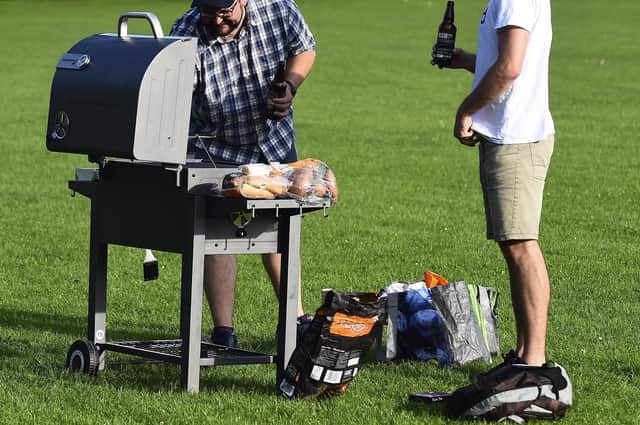BBQ next week, dinner party next month? How Scottish & English lockdown plans compare


The UK Government has been keen to stress the idea of a four-nations approach, but there have been stresses and strains on London’s relationship with Edinburgh, Cardiff and Belfast over how information has been shared and released to the public. Nicola Sturgeon has also insisted that she is putting scientific advice and public health ahead of constitutional politics.
Following the release of the Scottish Government’s routemap to easing the lockdown, the Scottish Tories described it as the UK plan “2.0”, and Downing Street welcomed it as an example that “the UK-wide approach is working”.
Advertisement
Hide AdAdvertisement
Hide Ad“We set out the road map a few weeks ago and now the devolved administrations are following that path at the right speed for them,” a Number 10 spokesman said. But how similar are the approaches of the Scottish and UK Governments?
In the first instance, there are clear differences in the way the two plans are presented. The Scottish Government has set out a four-stage process that maps out the easing of measures through to the near total suppression of the virus, to the point that it is no longer a threat to public health. Each step is matched to conditions for sustained decline in the R value that measures virus transmission and new cases. Crucially, further steps after the initial easing on 28 May depend on the condition that “any signs of resurgence are closely monitored as part of enhanced community surveillance” - meaning a test, track and trace system is in place and functioning well.
The Scottish Government has set out what each step will mean for meeting friends and family, getting around, work, health and social care, retail and hospitality, sport and culture, public services, and public gatherings. In its recovery plan, the UK Government has mapped out two further steps for easing the lockdown, but offers less detail about what each will mean, and does not commit to specific measures in every area.
For instance, in the crucial area of social and family contact, the UK Government plan for England says only that ministers and advisers are “considering a range of options” for allowing people from different households to meet beyond the current restrictions - which state that only two people from different households should meet one-to-one, and only outside. This led to confusion over whether it was possible for someone to meet both their parents in the park. The Foreign Secretary Dominic Raab initially suggested that was possible, before being corrected by Downing Street.
The UK Government says it has “asked SAGE [the Scientific Advisory Group for Emergencies] to examine whether, when and how it can safely change the regulations to allow people to expand their household group to include one other household in the same exclusive group”. It says a New Zealand model of two-household bubbles could be applied, but also suggests gatherings could be based on numbers of people rather than households. The detail has yet to be confirmed, and there is currently no indication of when family members might be able to meet in their own homes, leading to criticism of rules that will allow cleaners and house viewers to enter a property, but not someone’s parents. “Over the coming weeks, the Government will engage on the nature and timing of the measures in this step,” the plan for England states in relation to step 2 - the very next in line.
In contrast, the Scottish Government sets out what people can expect on social contact at every stage. There are also significant differences: from 28 May, Scots will be able to interact with people they don’t live with “in small numbers, including in gardens”. The Scottish plan also makes clear that meetings of “larger groups including family and friends outside” will be possible at stage three, as will “meeting people from another household indoors with physical distancing and hygiene measures”. At stage four, meetings indoors with people from three or more households will be possible.
In Scotland, it’s much more clear what the future will bring. A BBQ round the neighbours could be on the cards in less than a week, while in England, other people’s homes remain off limits.
The Scottish Government is also being more detailed - and more prescriptive - when it comes to moving around for leisure. In England, people have already been told they can travel any distance to spend time outside, leading to fears that beauty spots and remote areas like the Lake District and seaside towns could be overwhelmed.
Advertisement
Hide AdAdvertisement
Hide AdIn Scotland, at stage one people are advised to stay “broadly within five miles” of home, and “travel by walk, wheel and cycle where possible”.
A message from the Editor:
Thank you for reading this story on our website. While I have your attention, I also have an important request to make of you.
With the coronavirus lockdown having a major impact on many of our advertisers - and consequently the revenue we receive - we are more reliant than ever on you taking out a digital subscription.
Subscribe to scotsman.com and enjoy unlimited access to Scottish news and information online and on our app. With a digital subscription, you can read more than 5 articles, see fewer ads, enjoy faster load times, and get access to exclusive newsletters and content. Visit https://www.scotsman.com/subscriptions now to sign up.
Our journalism costs money and we rely on advertising, print and digital revenues to help to support them. By supporting us, we are able to support you in providing trusted, fact-checked content for this website.
Joy Yates
Editorial Director